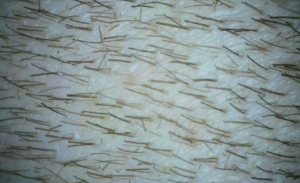DUPA or not DUPA in a potential hair transplant patient.
A 30-year-old man contacted me for surgery. As usual, I had him purchase a hand microscope and a micrometer. We went on Zoom, where he took control of his hand microscope. First, we used the micrometer. He measured his donor hairs (about 20 of them), and they ranged from 30 microns to 91 microns, averaging 50 microns. There was wide variation in the hair thickness of the donor area, which suggests DUPA. Then we went to the hand microscope, and he had some follicular groups with all miniaturized hairs, some with partial miniaturized hairs, and many normal groups. From what I saw, which was limited, I assumed that he had DUPA and eliminated the planned surgery for his immediate future. Of interest, he had met with 3 surgeons before contacting me; one was very well-known and respected. None of the three surgeons picked up on the DUPA diagnosis. All surgeons must examine their patients before surgery, looking for this disease, before they book the patient for a hair transplant.
THE IMPORTANT LESSON HERE IS TO MAKE SURE YOUR SURGEON DOES A MICROSCOPIC EXAMINATION OF YOUR DONOR AREA AND MEASURES YOUR HAIR THICKNESS WITH A MICROMETER. THESE TOOLS LET YOU KNOW (1) THE HEALTH OF YOUR DONOR AREA, (2) YOUR LIFETIME HAIR SUPPLY, (3) YOUR DONOR DENSITY, (4) YOUR HAIR MASS WHICH REFLECTS THE RESULTS YOU WILL GET FROM A HAIR TRANSPLANT.
This is a picture of this patient’s donor area (click to enlarge to full screen)


Reader Comments0
Share this entry
Leave a Comment
Want to join the discussion? Feel free to contribute! Note: We do not tolerate offensive language or personal attacks to other readers. Marketing links or commercial advertisements will be deleted.